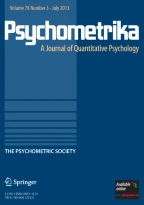Abstract
A Monte Carlo evaluation of thirty internal criterion measures for cluster analysis was conducted. Artificial data sets were constructed with clusters which exhibited the properties of internal cohesion and external isolation. The data sets were analyzed by four hierarchical clustering methods. The resulting values of the internal criteria were compared with two external criterion indices which determined the degree of recovery of correct cluster structure by the algorithms. The results indicated that a subset of internal criterion measures could be identified which appear to be valid indices of correct cluster recovery. Indices from this subset could form the basis of a permutation test for the existence of cluster structure or a clustering algorithm.
Similar content being viewed by others
Reference notes
Downton, M., & Brennan, T. Comparing classifications: An evaluation of several coefficients of partition agreement. Paper presented at the meeting of the Classification Society, Boulder, Colorado, June 1980.
Dudewicz, E. J.IRCCRAND-The Ohio State University random number generator package (Tech. Rep. No. 104). Columbus, Ohio: The Ohio State University, Department of Statistics, 1974.
Edelbrock, C., & McLaughlin, B. Intraclass correlations as metrics for hierarchical cluster analysis: Parametric comparisons using the mixture model. Paper presented at the meeting of the Classification Society, Gainesville, Florida, April 1979.
Fowlkes, E. B., & Mallows, C. L.A new measure of similarity between two hierarchical clusterings and its use in studying hierarchical clustering methods. Paper presented at the meeting of the Classification Society, Boulder, Colorado, June 1980.
Learmonth, G. P., & Lewis, P. A. W.Naval Postgraduate School random number generator package LLRANDOM (Tech. Rep. NPS55LW73061A). Monterey, Calif.: Naval Postgraduate School, Department of Operations Research and Administrative Sciences, 1973.
References
Arnold, S. J. A test for clusters.Journal of Marketing Research, 1979,16, 545–551.
Anderberg, M. R.Cluster analysis for applications. New York: Academic Press, 1973.
Baker, F. B., & Hubert, L. J. Measuring the power of hierarchical cluster analysis.Journal of the American Statistical Association, 1972,70, 31–38.
Blashfield, R. K. Mixture model tests of cluster analysis: Accuracy of four agglomerative hierarchical methods.Psychological Bulletin, 1976,83, 377–388.
Cormack, R. M. A review of classification.Journal of the Royal Statistical Society, Series A, 1971,134, 321–367.
Dudewicz, E. J. Speed and quality of random numbers for simulation.Journal of Quality Technology, 1976,8, 171–178.
Edelbrock, C. Comparing the accuracy of hierarchical clustering algorithms: The problem of classifying everybody.Multivariate Behavioral Research, 1979,14, 367–384.
Friedman, H. P., & Rubin, J. On some invariant criteria for grouping data.Journal of the American Statistical Association, 1967,62, 1159–1178.
Guilford, J. P., & Fruchter, B.Fundamental statistics in Psychology and Education. New York: McGraw-Hill, 1973.
Hartigan, J. A.Clustering algorithms. New York: Wiley, 1975.
Hubert, L. J., & Levin, J. R. A general statistical framework for assessing categorical clustering in free recall.Psychological Bulletin, 1976,83, 1072–1080.
Jardine, N., & Sibson, R.Mathematical taxonomy. New York: Wiley, 1971.
Johnson, S. C. Hierarchical clustering schemes.Psychometrika, 1967,32, 241–254.
Lingoes, J. C. & Cooper, T. PEP-I: A FORTRAN IV (G) program for Guttman-Lingoes nonmetric probability clustering.Behavioral Science, 1971,16, 259–261.
McClain, J. O., & Rao, V. R. CLUSTISZ: A program to test for the quality of clustering of a set of objects.Journal of Marketing Research, 1975,12, 456–460.
Milligan, G. W. An examination of the effect of six types of error perturbation on fifteen clustering algorithms.Psychometrika, 1980,45, 325–342.
Milligan, G. W., & Isaac, P. D. The validation of four ultrametric clustering algorithms.Pattern Recognition, 1980,12, 41–50.
Milligan, G. W., & Mahajan, V. A note on procedures for testing the quality of a clustering of a set of objects.Decision Sciences, 1980,11, 669–677.
Rand, W. M. Objective criteria for the evaluation of clustering methods.Journal of the American Statistical Association, 1971,66, 846–850.
Rohlf, F. J. Methods of comparing classifications.Annual Review of Ecology and Systematics, 1974,5, 101–113.
Rohlf, F. J., & Fisher, D. R. Tests for hierarchical structure in random data sets.Systematic Zoology, 1968,17, 407–412.
Sneath, P. H. A. Evaluation of clustering methods. In A. J. Cole, (Ed.),Numerical taxonomy. New York: Academic Press, 1969.
Sneath, P. H. A. Basic program for a significance test for clusters in UPGMA dendrograms obtained from squared euclidean distance.Computer Geosciences, 1979,5, 127–137.(a)
Sneath, P. H. A. Basic program for a significance test for 2 clusters in euclidean space as measured by their overlap.Computer Geosciences, 1979,5, 143–155.(b)
Williams, W. T., Clifford, H. T., & Lance, G. N. Group-size dependence: A rationale for choice between numerical classifications.Computer Journal, 1971,14, 157–162.
Author information
Authors and Affiliations
Rights and permissions
About this article
Cite this article
Milligan, G.W. A monte carlo study of thirty internal criterion measures for cluster analysis. Psychometrika 46, 187–199 (1981). https://doi.org/10.1007/BF02293899
Received:
Revised:
Issue Date:
DOI: https://doi.org/10.1007/BF02293899
